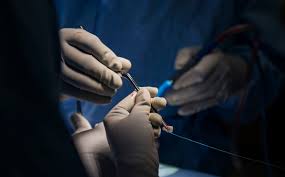When the term spinal surgery comes into our mind, we naturally thought about large incisions, long recovery periods, and painful rehab. Fortunately, surgical advances like the microdiscectomy spine surgery procedure have improved the process.
Microdiscectomy spine surgery is a minimally invasive surgical procedure performed on patients with a herniated lumbar disc. During this surgery, a surgeon will remove portions of your herniated disc to relieve pressure on the spinal nerve column. It is also sometimes called microdecompression or microdiskectomy.
Who benefits from microdiscectomy surgery?
If you’re wondering that if you’re a candidate of microdiscectomy spine surgery or not then here are you answer. You are a candidate if you have any or more of the following symptoms;
- Significant pain, numbness or weakness in your leg or foot
- Leg pain (sciatica) worse than back pain
- Symptoms that have not improved with exercise, physical therapy or any medication
- Diagnostic tests (MRI, CT, myelogram) shows a herniated disc
- Weakness in leg, loss of feeling in the genital area, and loss of bladder or bowel control (Cauda equina syndrome)
How surgery is performed?
As microdiscectomy spine surgery is performed through back so the patient lies face down on the operating table. Steps are as follow;
- A 1 to 1½-inch incision is made in the midline of the low back.
- The back muscles are lifted off the bony arch of the spine and moved to the side.
- The surgeon is now able to enter the spine by removing a membrane over the nerve roots.
- In some cases, a small portion of the inside facet joint is removed to facilitate access to the nerve root and to relieve any pressure or pinching on the nerve.
- The surgeon may make a small opening in the bony lamina if needed to access the operative site.
- The nerve root is then gently moved to the side.
- The surgeon uses small instruments to go under the nerve root and remove the piece of disc material that have exude out of the disc.
- The muscles are then moved back into place.
- The surgical incision is closed and stereo-strips are placed over the incision to help hold the skin in place to heal.
Complications of microdiscectomy spine surgery
As with any other surgery, there are some risks and complications with microdiscectomy spine surgery which are;
- Bleeding
- Infection
- Possible buildup of fluid in the lungs that may lead to pneumonia
- Deep vein thrombosis, which occurs when blood clots form in the leg
- Pain that persists after the surgery
- Nerve root damage
- Bowel/bladder incontinence
Success rate of microdiscectomy spine surgery
The success rate for microdiscectomy spine surgery is generally high, with one extensive medical study showing good or excellent results overall for 84% of people who have the procedure done.

